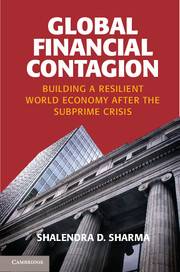Book contents
- Frontmatter
- Contents
- List of Figures
- List of Tables
- Acknowledgments
- Introduction
- One The United States
- Two The Bush and Obama Administrations’ Response
- Three From the U.S. to the European Crisis
- Four The Eurozone’s Sovereign-Debt Crisis
- Five Russia
- Six China
- Seven Japan, South Korea, and India
- Eight The Middle East amid the Global Financial Crisis
- Nine The Great Recession and the World’s Poorest
- Ten G-20 World
- Bibliography
- Index
Three - From the U.S. to the European Crisis
Published online by Cambridge University Press: 05 June 2014
- Frontmatter
- Contents
- List of Figures
- List of Tables
- Acknowledgments
- Introduction
- One The United States
- Two The Bush and Obama Administrations’ Response
- Three From the U.S. to the European Crisis
- Four The Eurozone’s Sovereign-Debt Crisis
- Five Russia
- Six China
- Seven Japan, South Korea, and India
- Eight The Middle East amid the Global Financial Crisis
- Nine The Great Recession and the World’s Poorest
- Ten G-20 World
- Bibliography
- Index
Summary
In early September 2008, as the subprime-induced financial contagion began to rapidly spread throughout the U.S. financial system, Europeans were confident that their economy would remain immune. German finance minister Peer Steinbruck scornfully dismissed the financial crisis as an “American problem” – the result of Anglo-American greed and inept regulation that may very well cost the United States its “superpower status.” Similar sentiments were echoed in other European capitals (Nicoll 2008). Italy’s prime minister, Silvio Berlusconi, blamed the spreading crisis on the “speculative capitalism” of the United States, Gordon Brown, the British prime minister, noted that the crisis “has come from America,” French leaders flatly blamed the “le capitalisme sauvage” of the Anglo-Americans – excoriating their worship of the markets and lack of business ethics and moral discipline – and the Kremlin saw the crisis as a Western problem that would leave Russia unscathed (Evans-Pritchard 2008). Indeed, in June 2008, Russian president Dimitri Medvedev unabashedly predicted that the Russian ruble would be the future reserve currency of Eurasia (Trenin 2009).
It is hardly surprising, then, that on September 19, 2008, when the Bush administration finally cobbled together an unprecedented $700 billion “rescue plan” to help distressed financial companies, the Europeans condescendingly rebuffed Treasury Secretary Hank Paulson’s pleas for a collaborative U.S.-European rescue effort. However, Europe’s immunity was short-lived. The Europeans’ sense of hubris and complacency was abruptly shattered as the Continent began to scramble to prevent a fast-moving contagion from bringing down major banks, wrecking financial markets, and negatively impacting national economies (Table 3.1).
- Type
- Chapter
- Information
- Global Financial ContagionBuilding a Resilient World Economy after the Subprime Crisis, pp. 102 - 138Publisher: Cambridge University PressPrint publication year: 2013



